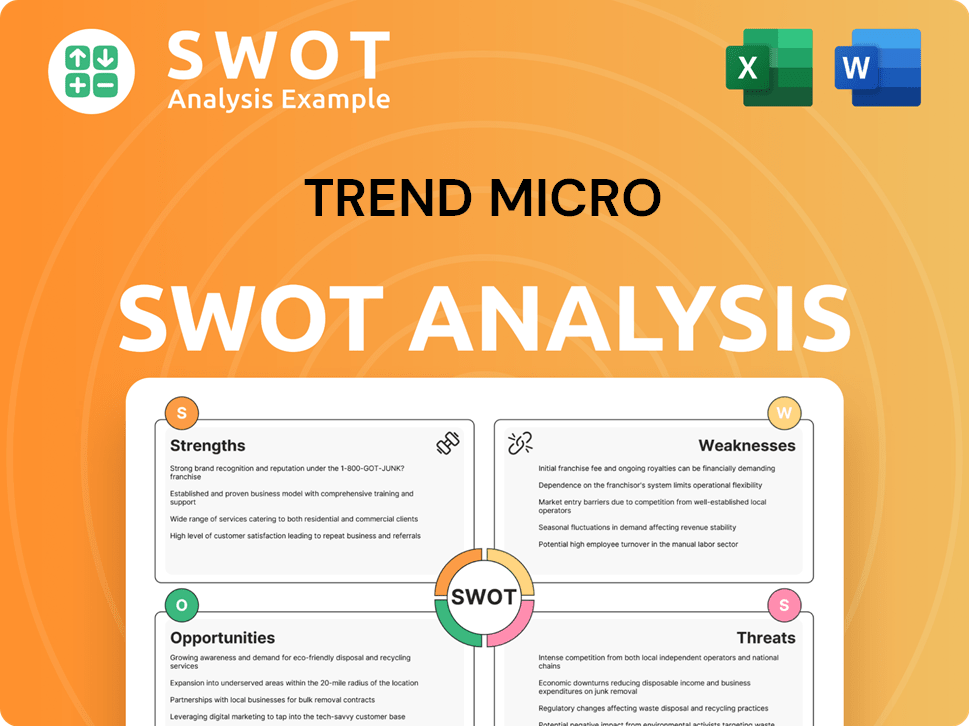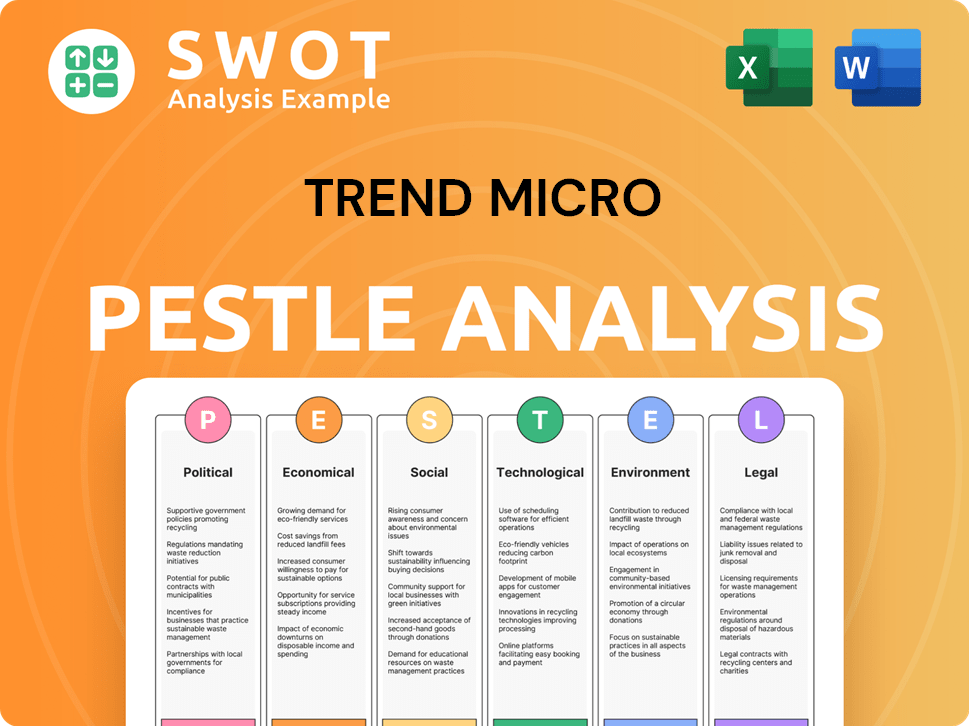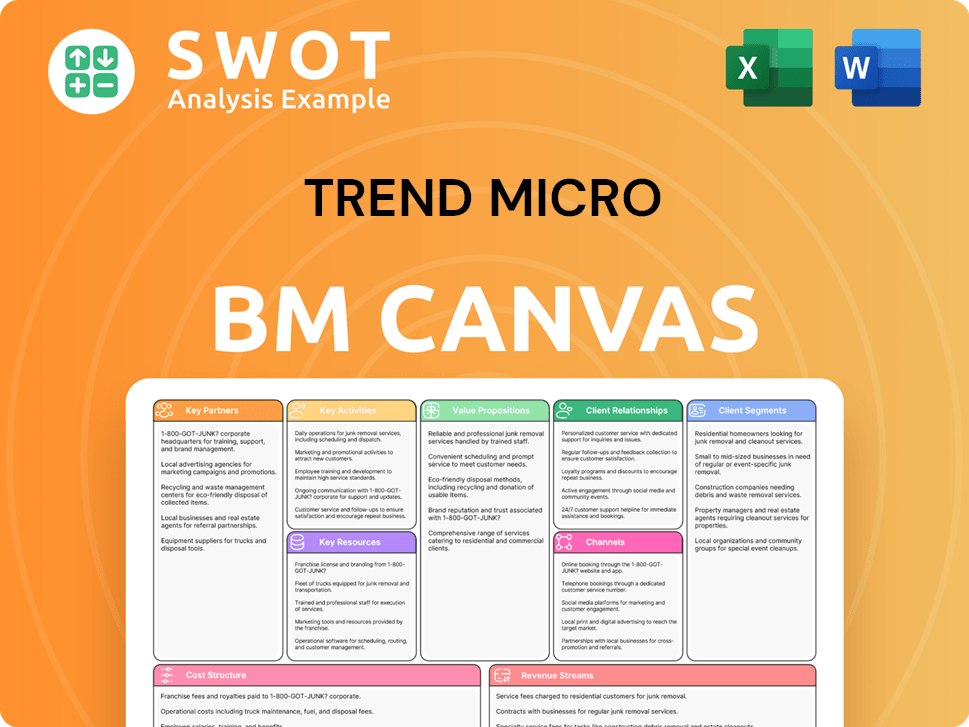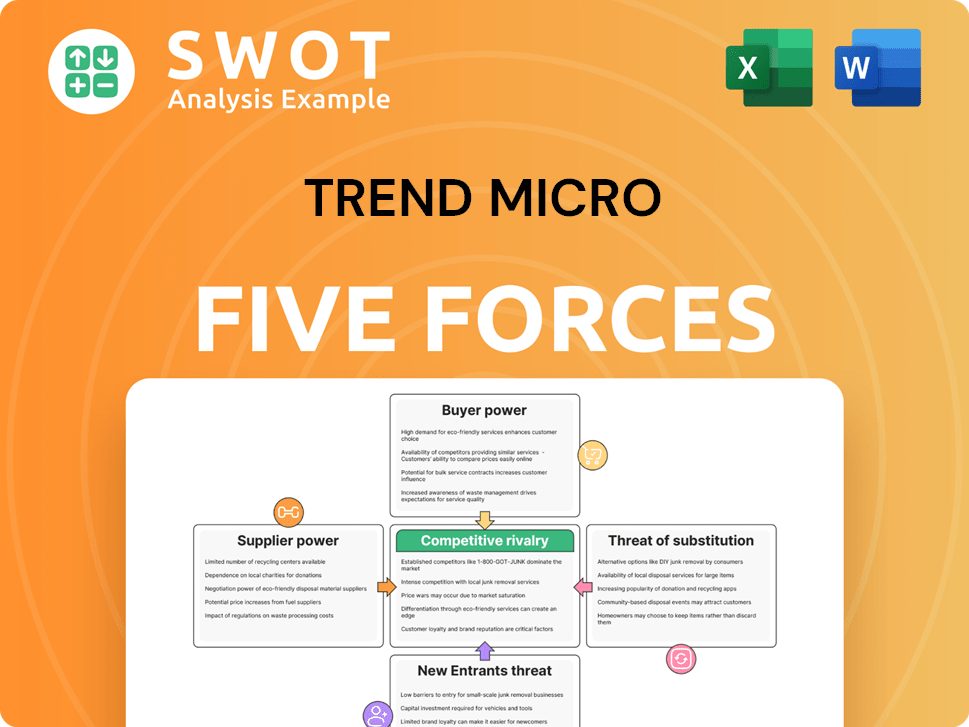Trend Micro Bundle
How Does Trend Micro Stack Up in the Cybersecurity Arena?
In today's digital age, safeguarding against cyber threats is paramount, making the Trend Micro SWOT Analysis a crucial read. The cybersecurity industry is a battlefield, with constant innovation and fierce competition. Understanding the Trend Micro competitive landscape is essential for investors, businesses, and anyone concerned with digital security.

This analysis will dissect Trend Micro competitors, evaluating their strengths and weaknesses within the cybersecurity industry. We'll explore Trend Micro market analysis, including its endpoint security and cloud security offerings, to provide a comprehensive understanding of its position. Expect insights into Trend Micro product comparison, pricing, and the overall Trend Micro industry position.
Where Does Trend Micro’ Stand in the Current Market?
Trend Micro holds a significant position within the global cybersecurity market, particularly in cloud security, endpoint security, and network defense. The company consistently ranks among the top providers in various segments, demonstrating a strong presence in the cybersecurity industry. Its core operations revolve around providing comprehensive security solutions to protect businesses and individuals from cyber threats.
The value proposition of Trend Micro lies in its ability to offer integrated security platforms that simplify threat detection and response. Its flagship platform, Trend Vision One, provides extended detection and response (XDR) capabilities. This allows organizations to proactively defend against a wide range of cyber threats. Trend Micro's focus on cloud-native security and XDR platforms aligns with the evolving needs of businesses undergoing digital transformation.
Geographically, Trend Micro maintains a robust global presence, with operations and customer bases spanning North America, Europe, Asia-Pacific, and other regions. Its customer segments range from large enterprises and government organizations to small and medium-sized businesses and individual consumers. The company has a strong financial foundation, enabling continued investment in research and development.
Trend Micro is recognized as a leader in the IDC MarketScape for Worldwide Modern Endpoint Security for Small and Midsize Businesses in 2024. While specific market share figures fluctuate, the company consistently ranks among the top providers in various cybersecurity segments. This demonstrates its strong competitive position.
Trend Micro's primary product lines include Trend Vision One, its flagship cybersecurity platform, which offers extended detection and response (XDR) capabilities. It also provides specialized solutions for cloud security (Trend Micro Cloud One), network security, and endpoint protection. The company's product offerings cater to a wide range of security needs.
Trend Micro reported net sales of 64.9 billion yen (approximately 416 million USD) for the first quarter of fiscal year 2025. This financial performance underscores the company's substantial scale within the cybersecurity industry. Strong financial health enables continued investment in research and development.
Trend Micro has strategically shifted its focus towards cloud-native security and XDR platforms, aligning with the industry's digital transformation. This move reflects a proactive approach to threat detection and response. This shift has strengthened its position in the Marketing Strategy of Trend Micro.
Trend Micro's competitive advantages include a strong product portfolio, global presence, and financial stability. The company's focus on cloud security and XDR platforms positions it well in the evolving cybersecurity landscape. Its ability to offer integrated security solutions is a key differentiator.
- Leader in Endpoint Security for SMBs.
- Focus on Cloud-Native Security.
- Robust Global Presence.
- Strong Financial Performance.
Trend Micro SWOT Analysis
- Complete SWOT Breakdown
- Fully Customizable
- Editable in Excel & Word
- Professional Formatting
- Investor-Ready Format

Who Are the Main Competitors Challenging Trend Micro?
The cybersecurity market is fiercely competitive, and Trend Micro's competitive landscape reflects this dynamic environment. The company faces a multitude of rivals, from established industry giants to agile, emerging players. Understanding these competitors is crucial for assessing Trend Micro's market position and future prospects. The cybersecurity industry is constantly evolving, with new threats and technologies emerging regularly, making the competitive analysis a continuous process.
Trend Micro's ability to innovate and adapt to these changes is critical for maintaining its market share. The company's success depends on its capacity to not only defend against current threats but also anticipate and prepare for future challenges. This requires continuous investment in research and development, as well as strategic partnerships and acquisitions. The competitive landscape is further shaped by mergers and acquisitions, which can quickly alter the balance of power in the industry.
Trend Micro's primary direct competitors include Palo Alto Networks, Fortinet, CrowdStrike, and Broadcom (Symantec). These companies offer a range of cybersecurity solutions that overlap with Trend Micro's offerings, creating direct competition in various market segments. Indirect competitors include niche security providers specializing in areas like identity and access management or SIEM.
Palo Alto Networks is a major competitor, particularly in enterprise network and cloud security. They are known for their next-generation firewalls and cloud security offerings. In 2024, Palo Alto Networks reported a total revenue of approximately $7.7 billion.
Fortinet offers a wide range of security products, including firewalls and endpoint security. They compete with Trend Micro across various segments. Fortinet's revenue for 2024 was around $6.3 billion.
CrowdStrike is a key player in endpoint protection and XDR, leveraging its cloud-native platform. They are a significant competitor in the endpoint security market. CrowdStrike's annual revenue for fiscal year 2024 was about $3.06 billion.
Broadcom, through its acquisition of Symantec, is a major competitor, especially in endpoint and data loss prevention. The acquisition has significantly reshaped the competitive landscape. Broadcom's cybersecurity revenue is a part of its overall business, with the exact figures varying. The company's overall revenue for fiscal year 2024 was approximately $42.9 billion.
Zscaler and Netskope are indirect competitors, especially in the cloud security space, focusing on SASE and CASB solutions. These companies compete for market share in cloud security. Zscaler's revenue for fiscal year 2024 was around $2.04 billion.
Numerous niche providers specialize in areas like identity and access management, data encryption, or SIEM. These companies offer specialized solutions that may integrate with or compete with Trend Micro's broader offerings. The market share of these providers varies.
The cybersecurity industry is marked by constant innovation, mergers, and acquisitions. Trend Micro must continually adapt to stay competitive. Understanding the competitive landscape is essential for making informed investment decisions. Trend Micro's market share in 2024 is estimated to be around 5-7% in the global cybersecurity market.
- Product Comparison: Comparing features, pricing, and effectiveness of Trend Micro's products against competitors is crucial.
- Market Analysis: Analyzing market trends, customer reviews, and threat intelligence capabilities helps understand the competitive advantages.
- Financial Performance: Monitoring Trend Micro's financial performance and industry position provides insights into its ability to compete.
- SWOT Analysis: Conducting a SWOT analysis (Strengths, Weaknesses, Opportunities, Threats) provides a comprehensive view of Trend Micro's position.
Trend Micro PESTLE Analysis
- Covers All 6 PESTLE Categories
- No Research Needed – Save Hours of Work
- Built by Experts, Trusted by Consultants
- Instant Download, Ready to Use
- 100% Editable, Fully Customizable

What Gives Trend Micro a Competitive Edge Over Its Rivals?
Understanding the Growth Strategy of Trend Micro requires a deep dive into its competitive advantages within the dynamic cybersecurity industry. These advantages are crucial for maintaining its market position and driving future growth. Trend Micro's success is built on a foundation of advanced threat intelligence, a comprehensive suite of security solutions, and strong customer relationships. These factors collectively contribute to its ability to compete effectively in a crowded market.
Trend Micro's competitive edge is further enhanced by its innovative technologies and strategic partnerships. The company continuously invests in research and development to stay ahead of emerging cyber threats. This proactive approach, combined with its established brand reputation, positions it favorably against competitors. The evolution from traditional antivirus to a sophisticated, AI-driven platform reflects its commitment to adapting to the evolving cybersecurity landscape.
The company's primary leverage comes from its continuous investment in research and development, allowing it to stay ahead of cybercriminals. These advantages have evolved from its early focus on antivirus to a more sophisticated, AI-driven threat defense platform. Trend Micro leverages these advantages in product development by integrating the latest threat intelligence, in marketing by emphasizing its comprehensive protection, and in strategic partnerships by offering robust security layers to other technology providers. These advantages are largely sustainable due to the ongoing need for advanced threat intelligence and integrated security solutions, though they face constant threats from rapid technological shifts and aggressive innovation by rivals.
Trend Micro's Vision One platform provides extended detection and response (XDR) capabilities, integrating security across endpoints, email, cloud, and networks. This unified approach enhances threat visibility and streamlines incident response. The platform's ability to correlate data from various sources provides a more holistic view of threats, improving overall security posture.
Trend Micro's proprietary technology excels in quickly identifying and neutralizing emerging threats, such as ransomware and phishing attacks. Their research consistently uncovers new vulnerabilities and attack methods, which are then integrated into their products. This proactive approach ensures that customers are protected against the latest cyber threats.
Trend Micro has built strong brand equity and customer loyalty over decades in the cybersecurity industry. Many enterprises and government agencies have relied on Trend Micro for years, valuing its reliability and customer support. This long-standing trust provides a significant competitive advantage in the market.
The company benefits from a robust distribution network, including channel partners and service providers, which extends its global reach. This extensive network allows Trend Micro to effectively deliver its cybersecurity solutions to a wide range of customers. The strong distribution network is crucial for market penetration and customer acquisition.
Trend Micro's competitive advantages are multifaceted, encompassing technological innovation, brand reputation, and strategic partnerships. These elements work together to provide a robust defense against cyber threats and maintain a strong market position. The company's ability to adapt and innovate is crucial in the ever-changing cybersecurity landscape.
- Advanced Threat Intelligence: Trend Micro's ability to quickly identify and neutralize emerging threats.
- Comprehensive Security Solutions: A broad portfolio of security products covering various aspects of cybersecurity.
- Customer Loyalty: Strong relationships with a diverse customer base built over years.
- Strategic Partnerships: Collaborations that extend its reach and enhance its capabilities.
Trend Micro Business Model Canvas
- Complete 9-Block Business Model Canvas
- Effortlessly Communicate Your Business Strategy
- Investor-Ready BMC Format
- 100% Editable and Customizable
- Clear and Structured Layout

What Industry Trends Are Reshaping Trend Micro’s Competitive Landscape?
The cybersecurity industry is experiencing dynamic shifts, presenting both challenges and opportunities for companies like Trend Micro. The increasing complexity of cyber threats, coupled with rapid technological advancements, requires continuous adaptation and innovation. A thorough Trend Micro market analysis is crucial to understanding its position and navigating the competitive landscape.
The Trend Micro competitive landscape is becoming increasingly crowded, with established players and new entrants vying for market share. Staying ahead of the curve requires a deep understanding of industry trends, emerging technologies, and the evolving needs of customers. This analysis will explore the key factors influencing Trend Micro's future and its ability to maintain a strong market position.
The cybersecurity industry is experiencing strong growth, with projections indicating continued expansion. Cloud computing, the proliferation of IoT devices, and remote work environments are increasing the attack surface. The demand for advanced threat detection and response solutions is rising.
Keeping pace with the accelerating rate of new threat emergence is a key challenge. The competitive landscape is intensifying, with new entrants offering specialized AI-driven security tools. The shift towards open-source security solutions or market consolidation poses potential risks.
The expansion of XDR and security service edge (SSE) markets presents growth opportunities. The increasing demand for OT/ICS security in industrial environments opens new market segments. Strategic partnerships with cloud providers and MSSPs can extend reach and enhance service delivery.
Focusing on AI and machine learning for predictive threat intelligence is essential. Expanding its cloud security footprint is crucial. Acquiring niche technology providers could strengthen its competitive position. These actions will help capitalize on emerging opportunities.
To succeed, Trend Micro must adapt to the rapidly changing cybersecurity landscape. This includes addressing the evolving threat landscape and the increasing demand for robust security solutions. Strategic partnerships and technological innovation are critical for long-term success.
- Cloud Security Solutions: The cloud security market is projected to reach $77.9 billion by 2028.
- Endpoint Security: The endpoint security market is expected to reach $23.7 billion by 2029.
- AI in Cybersecurity: The use of AI in cybersecurity is growing rapidly.
- Market Share: Understanding Trend Micro's market share 2024 is crucial for strategic planning.
Trend Micro Porter's Five Forces Analysis
- Covers All 5 Competitive Forces in Detail
- Structured for Consultants, Students, and Founders
- 100% Editable in Microsoft Word & Excel
- Instant Digital Download – Use Immediately
- Compatible with Mac & PC – Fully Unlocked

Related Blogs
- What are Mission Vision & Core Values of Trend Micro Company?
- What is Growth Strategy and Future Prospects of Trend Micro Company?
- How Does Trend Micro Company Work?
- What is Sales and Marketing Strategy of Trend Micro Company?
- What is Brief History of Trend Micro Company?
- Who Owns Trend Micro Company?
- What is Customer Demographics and Target Market of Trend Micro Company?
Disclaimer
All information, articles, and product details provided on this website are for general informational and educational purposes only. We do not claim any ownership over, nor do we intend to infringe upon, any trademarks, copyrights, logos, brand names, or other intellectual property mentioned or depicted on this site. Such intellectual property remains the property of its respective owners, and any references here are made solely for identification or informational purposes, without implying any affiliation, endorsement, or partnership.
We make no representations or warranties, express or implied, regarding the accuracy, completeness, or suitability of any content or products presented. Nothing on this website should be construed as legal, tax, investment, financial, medical, or other professional advice. In addition, no part of this site—including articles or product references—constitutes a solicitation, recommendation, endorsement, advertisement, or offer to buy or sell any securities, franchises, or other financial instruments, particularly in jurisdictions where such activity would be unlawful.
All content is of a general nature and may not address the specific circumstances of any individual or entity. It is not a substitute for professional advice or services. Any actions you take based on the information provided here are strictly at your own risk. You accept full responsibility for any decisions or outcomes arising from your use of this website and agree to release us from any liability in connection with your use of, or reliance upon, the content or products found herein.